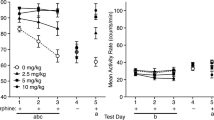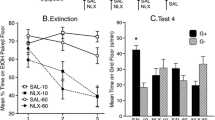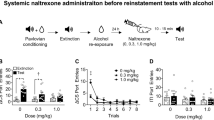Abstract
The effects of opioid antagonists on conditioned rewardproduced by ethanolprovide variable and sometimes conflicting results, especially in mice. In thepresent set of experiments, male C57BL/6 mice received 4 vehicle and 4 ethanol conditionings, and the rewarding effects of ethanol were assessed in an unbiased version of the conditionedplacepreference (CPP) apparatus and an unbiased stimulus assignmentprocedure. Intraperitoneal (ip) administration of ethanol (2 g/kg, but not 1 g/kg) resulted in the conditioned reward when conditionings lasted for 6 min but not when conditioning lasted for 20 min. Administration of the non-selective opioid receptor antagonist naloxone (1 and 5 mg/kg) before the conditionings attenuated the acquisition of ethanol-inducedplacepreference. Naloxone (1 mg/kg) also inhibited expression of the CPP response, but it did not alter thepreference of vehicle-conditioned mice, suggesting the lack of its own motivational effects in this experimental setting. Taken together, thepresent results suggest that an unbiased version of ethanol-induced CPP in C57BL/6 mice could be a valid model for the study of the motivational effects of ethanol, confirming and expandingprevious findings that have demonstrated inhibitory effects of opioid receptor antagonist on alcohol conditioned reward.
Similar content being viewed by others
References
Barr GA, Paredes W, Bridger WH: Place conditioning with morphine andphencyclidine: dose dependent effects. Life Sci, 1985, 36, 363–368.
Bechtholt AJ, Cunningham CL: Ethanol-induced conditionedplacepreference is expressed through a ventral tegmental area dependent mechanism. Behav Neurosci, 2005, 119, 213–223.
Benjamin D, Grant ER, Pohorecky LA: Naltrexone reverses ethanol-induced dopamine release in the nucleus accumbens in awake, freely moving rats. Brain Res, 1993, 621, 137–140.
Biała G, Kotlińska J: Blockade of the acquisition of ethanol-induced conditionedplacepreference by N-methyl-D-aspartate receptor antagonists. Alcohol Alcohol, 1999, 34, 175–182.
Biała G, Langwiński R: Rewardingproperties of some drugs studied byplacepreference conditioning. Pol Jpharmacol, 1996, 48, 425–430.
Boyce JM, Risinger FO: Enhancement of ethanol reward by dopamine D3 receptor blockade. Brain Res, 2000, 880, 202–206.
Carr GF, Fibiger HC, Phillips AG: Conditionedplacepreference as a measure of drug reward. In: The Neuro-pharmacological Basis of Reward. Eds. Liebman J, Cooper SJ, Clarendonpress, Oxford, 1989, 264–319.
Cunningham CL, Dickinson SD, Okorn DM: Naloxone facilitates extinction but does not affect acquisition or expression of ethanol-induced conditioned place preference. Exp Clinpsychopharmacol, 1995, 3, 330–343.
Cunningham CL, Ferree NK, Howard MA: Apparatus bias andplace conditioning with ethanol in mice. Psychopharmacology (Berl), 2003, 170, 409–422.
Cunningham CL, Henderson CM, Bormann NM: Extinction of ethanol-induced conditionedplacepreference and conditionedplace aversion: effects of naloxone. Psycho-pharmacology (Berl), 1998, 139, 62–70.
Cunningham CL, Niehus DR, Malott DH, Prather LK: Genetic differences in the rewarding and activating effects of morphine and ethanol. Psychopharmacology, 1992, 107, 385–393.
Cunningham CL, Prather LK: Conditioning trial duration affects ethanol-induced conditionedplacepreference in mice. Anim Learn Behav, 1992, 20, 187–194.
Fibiger HC, Phillips AG: Reward, motivation, cognition:psychobiology of mesotelencephalic dopamine systems. Handbook ofphysiology, Vol. IV. Intrinsic Regulatory Systems of the Brain. Ed. Bloom FE, Americanphysiology Society, Bethesda, MD, 1986, 647–675.
Herz A: Opioid reward mechanisms: a key role in drug abuse? Can Jphysiolpharmacol, 1998, 76, 252–258.
Houchi H, Babovic D, Pierrefiche O, Ledent C, Daoust M, Naassila M: CB1 receptor knockout mice display reduced ethanol-induced conditionedplacepreference and increased striatal dopamine D2 receptors. Neuropsycho-pharmacology, 2005, 30, 339–349.
Kotlińska J, Biała G, Rafalski P, Bocheński M, Danysz W: Effect of neramexane on ethanol dependence and reinforcement. Eur Jpharmacol, 2004, 503, 95–98.
Kuzmin A, Sandin J, Terenius L, Ogren SO: Acquisition, expression, and reinstatement of ethanol-induced conditionedplacepreference in mice: effects of opioid receptor-like 1 receptor agonists and naloxone. Jpharmacol Exp Ther, 2003, 304, 310–318.
Matsuzawa S, Suzuki T, Misawa M, Nagase H: Different roles of mu-, delta- and kappa-opioid receptors in ethanol-associatedplacepreference in rats exposed to conditioned fear stress. Eur Jpharmacol, 1999, 368, 9–16.
Middaugh LD, Bandy AL: Naltrexone effects on ethanol consumption and response to ethanol conditioned cues in C57BL/6 mice. Psychopharmacology (Berl), 2000, 151, 321–327.
Pettinati HM, O’Brien CP, Rabinowitz AR, Wortman SP, Oslin DW, Kampman KM, Dackis CA: The status of naltrexone in the treatment of alcohol dependence: specific effects on heavy drinking. J Clinpsychopharmacol, 2006, 26, 610–625.
Popik P, Kozela E, Wróbel M, Woźniak KM, Slusher BS: Morphine tolerance and reward but not expression of morphine dependence are inhibited by the selective glutamate carboxypeptidase II (GCP II, NAALADase) inhibitor, 2-PMPA. Neuropsychopharmacology, 2003, 28, 457–467.
Risinger FO, Boyce JM: 5-HT1A receptor blockade and the motivationalprofile of ethanol. Life Sci, 2002, 71, 707–715.
Tzschentke TM: Measuring reward with the conditionedplacepreference (CPP)paradigm: update of the last decade. Addict Biol, 2007, 12, 227–462.
Author information
Authors and Affiliations
Corresponding author
Rights and permissions
About this article
Cite this article
Wróbel, M. Acquisition and expression of ethanol-induced conditioned place preference in mice is inhibited by naloxone. Pharmacol. Rep 63, 79–85 (2011). https://doi.org/10.1016/S1734-1140(11)70401-7
Received:
Revised:
Accepted:
Published:
Issue Date:
DOI: https://doi.org/10.1016/S1734-1140(11)70401-7




